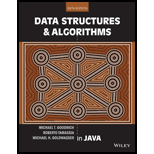
Data Structures and Algorithms in Java
6th Edition
ISBN: 9781118771334
Author: Michael T. Goodrich
Publisher: WILEY
expand_more
expand_more
format_list_bulleted
Concept explainers
Expert Solution & Answer
Chapter 4, Problem 42C
Explanation of Solution
findMax(Array A, size n>0):
max=A[0]
for i in 1 to n (inclusive)
if(A[i] > max)
max=A[i]
return max
Explanation:
The above algorithm uses a binary tree where every node keeps track of the maximum and minimum for the sub tree starting with that node.
Let us consider the three types as the following implementation to prove the maximum and minimum of “n” numbers. Type-1 contains less than “3n/2” comparisons, type-2 contains “n/2 ” nodes that have leaves as children, and type-3 contains less than “n/2” nodes where a least one of the children aren't leaves.
- First, start with the type 2 nodes, and compare the two leaves. This requires a maximum of “n/2” comparisons. If there are an odd number of type 1 nodes, the last node is promoted to type 2 and only it uses (n−1)/2 comparisons.
- Now there are “n/2 ” or “(n− 1)/2 + 1 ”type 2 nodes.
- Let us take “m” be the number of nodes and keep pairing the nodes until only one node is left. In each iteration, it requires two comparisons while pairing two nodes
Want to see the full answer?
Check out a sample textbook solution
Students have asked these similar questions
I need to define and discuss the uses of one monitoring or troubleshooting tool in Windows Server 2019. thank you
I would likr toget help with the following concepts:
- Windows Server features
- Windows Server versus Windows 10 used as a client-server network
I need to define and discuss the uses of one monitoring or troubleshooting tool in Windows Server 2019. thank you
Chapter 4 Solutions
Data Structures and Algorithms in Java
Ch. 4 - Prob. 1RCh. 4 - The number of operations executed by algorithms A...Ch. 4 - The number of operations executed by algorithms A...Ch. 4 - Prob. 4RCh. 4 - Prob. 5RCh. 4 - Prob. 6RCh. 4 - Prob. 7RCh. 4 - Prob. 8RCh. 4 - Prob. 9RCh. 4 - Prob. 10R
Ch. 4 - Prob. 11RCh. 4 - Prob. 12RCh. 4 - Prob. 13RCh. 4 - Prob. 14RCh. 4 - Prob. 15RCh. 4 - Prob. 16RCh. 4 - Prob. 17RCh. 4 - Prob. 18RCh. 4 - Prob. 19RCh. 4 - Prob. 20RCh. 4 - Prob. 21RCh. 4 - Prob. 22RCh. 4 - Show that 2n+1 is O(2n).Ch. 4 - Prob. 24RCh. 4 - Prob. 25RCh. 4 - Prob. 26RCh. 4 - Prob. 27RCh. 4 - Prob. 28RCh. 4 - Prob. 29RCh. 4 - Prob. 30RCh. 4 - Prob. 31RCh. 4 - Prob. 32RCh. 4 - Prob. 33RCh. 4 - Prob. 34RCh. 4 - Prob. 35CCh. 4 - Prob. 36CCh. 4 - Prob. 37CCh. 4 - Prob. 38CCh. 4 - Prob. 39CCh. 4 - Prob. 40CCh. 4 - Prob. 41CCh. 4 - Prob. 42CCh. 4 - Prob. 43CCh. 4 - Draw a visual justification of Proposition 4.3...Ch. 4 - Prob. 45CCh. 4 - Prob. 46CCh. 4 - Communication security is extremely important in...Ch. 4 - Al says he can prove that all sheep in a flock are...Ch. 4 - Consider the following justification that the...Ch. 4 - Consider the Fibonacci function, F(n) (see...Ch. 4 - Prob. 51CCh. 4 - Prob. 52CCh. 4 - Prob. 53CCh. 4 - Prob. 54CCh. 4 - An evil king has n bottles of wine, and a spy has...Ch. 4 - Prob. 56CCh. 4 - Prob. 57CCh. 4 - Prob. 58CCh. 4 - Prob. 59CCh. 4 - Prob. 60PCh. 4 - Prob. 61PCh. 4 - Perform an experimental analysis to test the...Ch. 4 - Prob. 63P
Knowledge Booster
Learn more about
Need a deep-dive on the concept behind this application? Look no further. Learn more about this topic, computer-science and related others by exploring similar questions and additional content below.Similar questions
- Please solve and answer the questions correctly please. Thank you!!arrow_forwardConsidering the TM example of binary sum ( see attached)do the step-by-step of execution for the binary numbers 1101 and 11. Feel free to use the Formal Language Editor Tool to execute it; Write it down the current state of the tape (including the head position) and indicate the current state of the TM at each step.arrow_forwardI need help on inculding additonal code where I can can do the opposite code of MatLab, where the function of t that I enter becomes the result of F(t), in other words, turning the time-domain f(t) into the frequency-domain function F(s):arrow_forward
arrow_back_ios
SEE MORE QUESTIONS
arrow_forward_ios
Recommended textbooks for you
 Systems ArchitectureComputer ScienceISBN:9781305080195Author:Stephen D. BurdPublisher:Cengage LearningProgramming Logic & Design ComprehensiveComputer ScienceISBN:9781337669405Author:FARRELLPublisher:Cengage
Systems ArchitectureComputer ScienceISBN:9781305080195Author:Stephen D. BurdPublisher:Cengage LearningProgramming Logic & Design ComprehensiveComputer ScienceISBN:9781337669405Author:FARRELLPublisher:Cengage C++ Programming: From Problem Analysis to Program...Computer ScienceISBN:9781337102087Author:D. S. MalikPublisher:Cengage Learning
C++ Programming: From Problem Analysis to Program...Computer ScienceISBN:9781337102087Author:D. S. MalikPublisher:Cengage Learning C++ for Engineers and ScientistsComputer ScienceISBN:9781133187844Author:Bronson, Gary J.Publisher:Course Technology Ptr
C++ for Engineers and ScientistsComputer ScienceISBN:9781133187844Author:Bronson, Gary J.Publisher:Course Technology Ptr Operations Research : Applications and AlgorithmsComputer ScienceISBN:9780534380588Author:Wayne L. WinstonPublisher:Brooks Cole
Operations Research : Applications and AlgorithmsComputer ScienceISBN:9780534380588Author:Wayne L. WinstonPublisher:Brooks Cole EBK JAVA PROGRAMMINGComputer ScienceISBN:9781337671385Author:FARRELLPublisher:CENGAGE LEARNING - CONSIGNMENT
EBK JAVA PROGRAMMINGComputer ScienceISBN:9781337671385Author:FARRELLPublisher:CENGAGE LEARNING - CONSIGNMENT

Systems Architecture
Computer Science
ISBN:9781305080195
Author:Stephen D. Burd
Publisher:Cengage Learning

Programming Logic & Design Comprehensive
Computer Science
ISBN:9781337669405
Author:FARRELL
Publisher:Cengage

C++ Programming: From Problem Analysis to Program...
Computer Science
ISBN:9781337102087
Author:D. S. Malik
Publisher:Cengage Learning

C++ for Engineers and Scientists
Computer Science
ISBN:9781133187844
Author:Bronson, Gary J.
Publisher:Course Technology Ptr

Operations Research : Applications and Algorithms
Computer Science
ISBN:9780534380588
Author:Wayne L. Winston
Publisher:Brooks Cole

EBK JAVA PROGRAMMING
Computer Science
ISBN:9781337671385
Author:FARRELL
Publisher:CENGAGE LEARNING - CONSIGNMENT